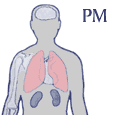
Nitrogen Dioxide

Ozone

Carbon Monoxide

Sulfur Dioxide

Particulate Matter

Lead
|
 
Particulate Matter - PM
Fine particulates are solid or liquid particles suspended in the air for long periods. Solid particles come from dust, dirt, soot and cigarette smoke. Liquid droplets are minute emissions from spray paint and toxic chemical compounds. Particulates can also contain sulfur, nitrogen, carbon and various toxic metals. Fine particulate matter, or PM10, is smaller than 10 microns in size or about 1/5th the diameter of a human hair, and can only be seen with a microscope. Because these invisible airborne particles are damaging to people, animals and plants, they are regulated by EPA. There is now a solid body of evidence that even smaller particles--as tiny as 2.5 microns--lodge deeper in the lungs and cause even more respiratory damage. Based on continuing research, EPA adopted revised standards for PM10 and new standards for PM2.5 in 1997.
Where
Fine particulate matter in the air comes from factories, power plants, transportation, construction jobs, fires, other combustion, and windblown dust. Particulates are also formed in the atmosphere when air pollutants like sulfur dioxide, nitrogen oxides, and volatile organic compounds condense or transform into tiny droplets. Specific sources of PM10 are dust from unpaved roads and shoulders, farming and construction; industrial processes; and wildfires and agricultural burning. PM2.5 comes from wood burning stoves and fireplaces; diesel and poorly maintained gasoline exhaust; nitrogen emissions from motor vehicles and boilers; and ammonia emissions from dairies.
Effects
Fine particulate matter not only reduces visibility, but is especially harmful because it can reach the deepest recesses of the lungs without being filtered out by the natural cleansing action of the respiratory system. Inhaled particles can irritate the respiratory tract, constrict airways, and interfere with their mucous lining. Fine particulates may also carry toxic materials into the lungs where they can be absorbed into the bloodstream and carried to other parts of the body.

Back to Criteria Pollutants in Depth
|

PM attacks the lungs

|
